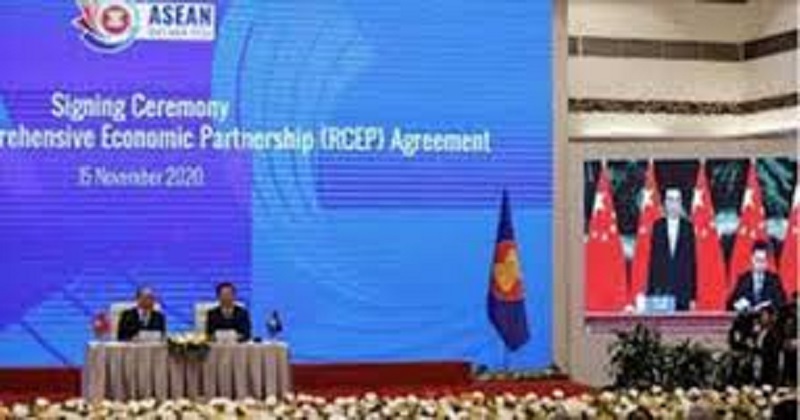
Beijing: 15 Asia-Pacific countries on Sunday signed the Regional Comprehensive Economic Partnership (RCEP), the world’s biggest trade deal, a move considered a huge coup for regional economic integration, multilateralism, and free trade, after eight years of negotiations.
“This is not only a gigantic accomplishment in East Asian regional cooperation but more significantly, a victory of multilateralism and free trade,” said Chinese Premier Li Keqiang at the fourth RCEP Summit held virtually. Leaders from the 15 nations, including 10 member countries of the Association of Southeast Asian Nations (ASEAN) and China, Japan, the Republic of Korea (ROK), Australia, and New Zealand, glimpsed the signing of the agreement after the conference.
Calling the treaty “the most promising FTA covering the largest population and most diverse membership,” Li said the signing “will inject new momentum into development and wealth of the region, and will contribute to the retrieval and growth of the world economy.”The RCEP agreement covers a market of 2.2 billion people, or almost 30 percent of the world’s population, with a combined GDP of $26.2 trillion or about 30 percent of global GDP.

It is an unprecedented regional trading arrangement that comprises a diverse mix of developed, developing, and least developed economies of the region, according to a joint statement published after the summit. The contract “is critical to the region’s response to the Covid-19 pandemic and will play an important role in building the region’s resilience through an inclusive and sustainable post-pandemic economic recovery process,” leaders said in the report.
“The trade pact marks a new milestone in regional economic integration in East Asia,” Chinese Vice Commerce Minister Wang Shouwen told in Beijing. According to Wang, the pact covers 20 chapters, including the market access of goods and services trade and investment as well as regulations for trade facilitation, intellectual property rights, e-commerce, and others. The pact will energetically upgrade confidence in regional trade and investment, improve the capability of all parties to unite in fighting the pandemic, hasten the economic recovery in all countries, and promote the long-term prosperity and development of the region, Wang said.
Cao Jing, Deputy Secretary-General of the Trilateral Cooperation Secretariat, indicated that the signing of RCEP will also help promote the negotiations on the trilateral open trade agreement among China, Japan, and the ROK as the leaders of the three countries consented to hasten up the FTA negotiations based on the RCEP negotiations last December. Cambodia’s Commerce Ministry Secretary of State and spokesman Seang Thay said the pact would boost trade liberalization in the region, give the member countries greater market permit and further extend the ties in economy, trade, and investment.
The RCEP agreement was signed at a time when the Covid-19 pandemic is still raging across the globe, and the world economy is in a serious recession with contracted global trade and investment and rising protectionism and unilateralism. Calling the signing of RCEP “light and hope through dark clouds,” the Chinese premier said at the summit that it shows that “multilateralism and free trade are the right way forward, and remain the right direction for promoting the growth of the world economy and the progress of humanity.”
Wang said RCEP supports trade and investment liberalization and facilitation with practical actions and will boost confidence in the global economy. The signing of the agreement shows that all members are set to reducing tariffs, opening up markets, and reducing barriers of standards, which sends a strong signal against unilateralism and protectionism, and effectively supports free trade and the multilateral trading system, said the vice commerce minister.
Ruan Zongze, Executive Vice President of the China Institute of International Studies, said the RCEP trade pact accommodates the broadest possible interests, conditions, and priorities of different countries, embodies the spirit of multilateralism, and sends a clear message of East Asian countries working together for shared prosperity. During the RCEP summit, leaders of participating countries agreed that RCEP remains open to India, which was due to sign but pulled out last year, and welcomed India to join the pact soon.
Analysts said that the signing of RCEP would facilitate China’s endeavor of a new “dual circulation” development pattern, where domestic and overseas markets reinforce each other, with the domestic market as the mainstay. All RCEP members are China’s important economic and trade partners. Statistics show that from January to September 2020, China’s total trade volume with other RCEP members reached $1.055 trillion, accounting for about one-third of China’s total foreign trade volume.
“The pact will help expand China’s export market, meet the needs of domestic import consumption, and strengthen regional industrial and supply chains,” said Wang. It contributes to stabilizing foreign trade and investment and effectively supports China’s new development pattern of “dual circulation,” he added.
During the summit, Li expressed the hope that the parties involved would complete their domestic approval procedures as soon as possible to allow the trade pact to take effect and benefit the enterprises and the people at an early date. According to Wang, the RCEP agreement will come into force only if at least nine members enact it, including at least six ASEAN members and at least three countries out of the other five non-ASEAN countries.

Post Your Comments